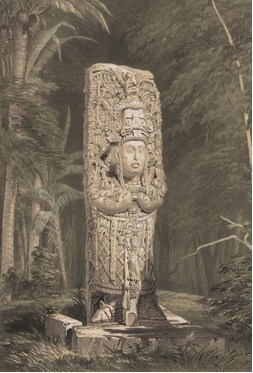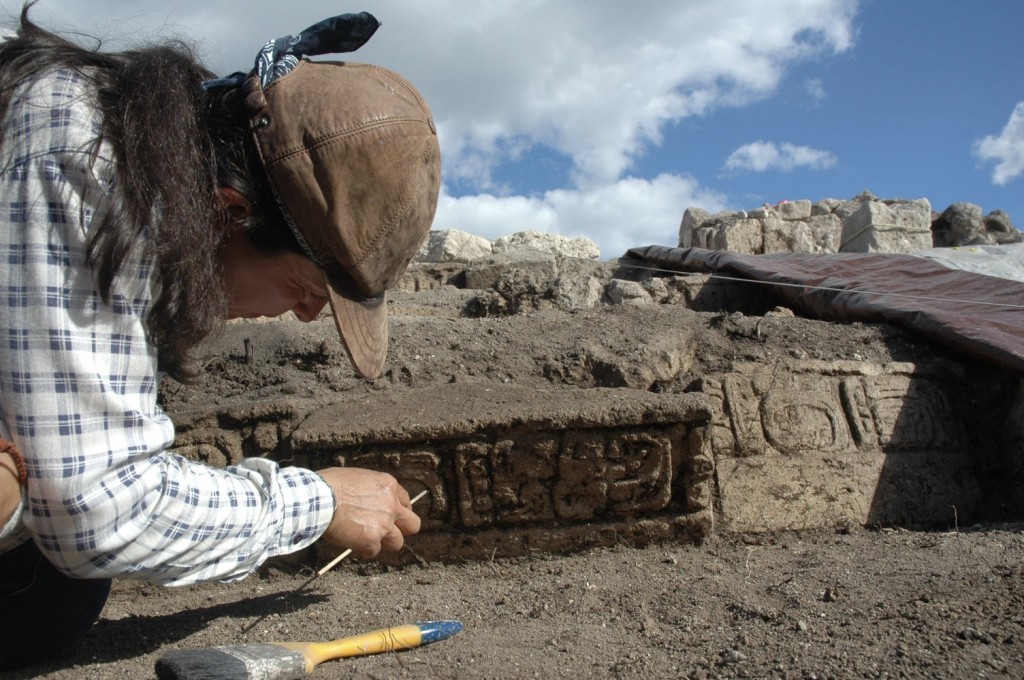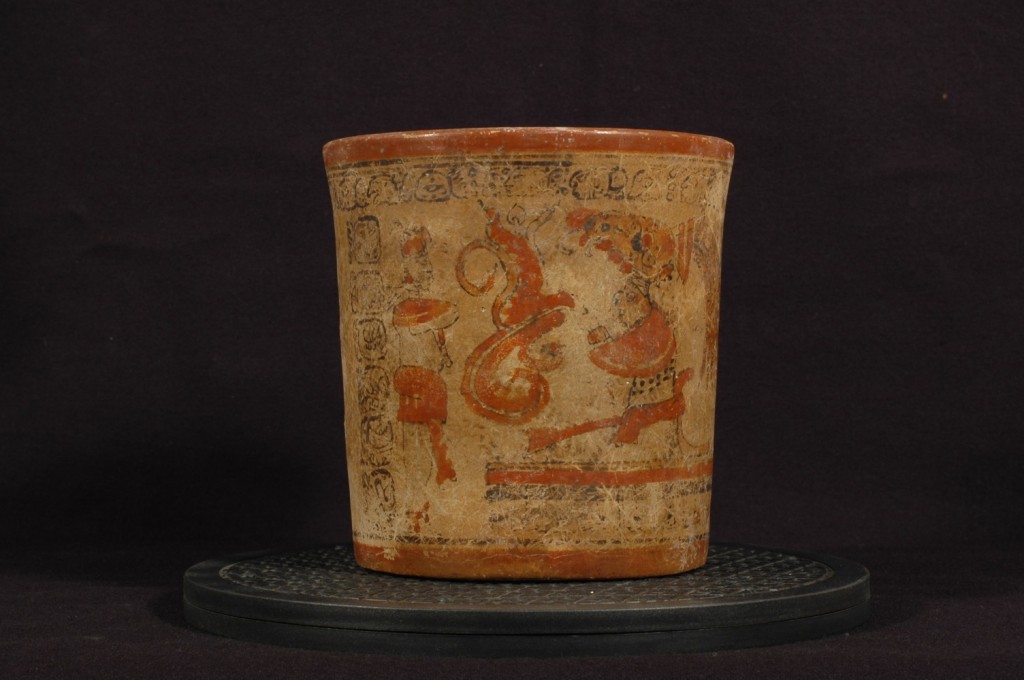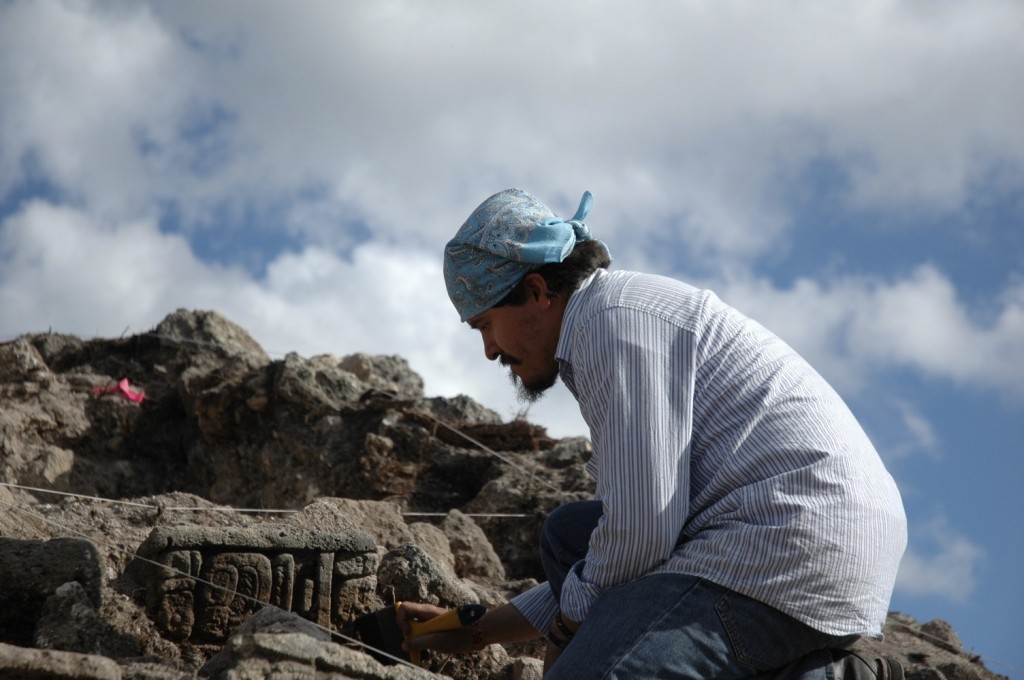
Our fascination with the Maya is credited to John Lloyd Stephens, a New York Lawyer who travelled to the Yucatan and Central America in the 1840s, and Frederick Catherwood, an Englishman whose mission was to visually document the journey, a talent that has inspired many of us in becoming archaeologists.
Along with multi-leveled stepped pyramids, ball courts, plazas and freestanding monuments called Stelae, the Maya also literally told the stories of their parents, ancestors, founders, foes, captured enemies and military alliances. Maya writing is a unique feature of this culture that along with the perfection of their calendar has intrigued and mystified the world. Their texts are expressions of a ruling class, however, the question remains, are we reading history, political propaganda or both?
New Hieroglyphic Stairway Found

It is not often that a young archaeologist stumbles upon a spectacular find. Kenichiro Tsukamoto, a young Japanese archaeologist and Ph.D. candidate at the University of Arizona, has found a "mountain" of texts in a recently discovered hieroglyphic stairway at the site of El Palmar in Campeche, Mexico. Funded in part by the National Geographic Society/ Waitt Grants Program, Kenichiro and his co-director Javier Lopez-Camacho have been focusing on retrieving ancient history by exploring and preserving the Guzmán hieroglyphic stairway at El Palmar. It is not an easy task since the recovery of these texts includes the important work of conservation efforts by their team who includes: Luz Evelia Campaña, Octavio Esparza, Hirokazu Kotegawa, and Vania Pérez. The exciting team of archaeologists, epigraphers and conservators together with the National Institute of Anthropology and History of Mexico [INAH] are studying, preserving and protecting this unique cultural patrimony.
Typically, hieroglyphic stairways are part of the central or core elements of the elite ruling class, however, this was not the case at El Palmar because the building was located on the outskirts of the site, away from the center. The location of the stairway perplexed Javier: "For me, the discovery of the hieroglyphic stairway at El Palmar was a great surprise. When Kenichiro notified me of the architectural group away from the central zone, I assumed that it would be similar to El Resbalon in Quintana Roo, where Post-Classic inhabitants reused the abandoned city, taking apart the hieroglyphic stairway and using the carved blocks for new constructions, placing them out of order in other parts of the city".
What Javier is referring to is yet another complex part of ancient Maya history. After the Classic period, there is a regional hiatus in writing, commemorative dates and construction. This initially led to the notion of the Maya "Collapse". A term that has created more confusion than clarification since it implies the disappearance of a culture, but the Maya people never disappeared, and the term rather addresses a dissolution of government and society. Although we still don't know much about the causes of the "collapse", the following Post-Classic period, dated between 900-1200 A.D., was a time of major change. Many of the cities that were abandoned at the end of the Classic were re-occupied. Old palaces and sacred temples were used by newcomers, in many cases, they would re-utilize carved stones in new constructions, adding more confusion to modern archaeologists trying to "read" texts taken out of their original context.
The uniqueness of the Guzmán stairway is that it lies in the periphery of the main architectural group, since most hieroglyphic stairways have been found at the heart of major Classic Maya cities. Furthermore these stairways are associated with monumental structures surrounding huge plazas, but the Guzmán stairway was discovered in the smallest architectural group of the ancient city. It clearly was not a Post-Classic building and so we are looking at a new type of Maya sacred space, one that has not been previously documented and which may shed light into their history. At present, there are only about 20 other centers with hieroglyphic stairways in the Maya region, most of them have suffered changes through time, re-occupation, re-use of materials, and are difficult to read. In this regard the Guzmán group is not only unique, but also important in revealing new information on Maya society.
How was the Guzman Hieroglyphic Stairway Discovered?

Despite the fact that most of the hieroglyphic stairway was still covered with debris and soil, Kenichiro and his team realized the stairway remnants were close to the surface, making these remarkable inscriptions highly vulnerable to looting. Therefore, a salvage excavation was extremely urgent.

The excavation project that was soon to follow was no easy task. It required experienced archaeologists like Luz Evelia, whose previous works at the Sites of Dzibanche and Becán was essential to the success of the research. Their first task was to remove the overgrown jungle from the stairway and then to carefully excavate the monument without causing any damage to the fragile texts. Loosing a block could mean erasing part of history. What many don't realize is that after the blocks are documented they need to be cared for by a team of conservators. At El Palmar, the conservation team included: Yareli Jáidar Benavides, from the National Coordination of Conservation of Cultural Heritage (CNCPC) of INAH, Diana Arano Recio and Leticia Jiménez Hernández from the Campeche INAH Center. It was the Institutional collaboration from the Director of the Campeche INAH Center, Lirio Guadalupe Suarez that provided the staff, lab, time and effort in preserving this spectacular find.
What We Know So Far
Much more time is needed to decipher the hieroglyphic stairway. However, so far the data recovered and the texts suggest a very intriguing story. The pyramidal structure that holds the stairway was built between the 7th and 8th Centuries A.D. and a few decades after its construction a total of 90 blocks containing Maya glyphs were added, creating a stairway of six steps leading to a temple on top of the pyramid.
Octavio has partially deciphered the stairway inscriptions that commemorate an event dated probably to September 13, A.D. 726 [9.14.15.0.0 11 Ajaw 18 Sak], and provide a list of successive El Palmar rulers. Of the most exciting finds was that the hieroglyphic stairway commemorated the visit of rulers from two major Classic Maya capitals: Calakmul and Copán. "Octavio´s decipherment suggests that Calakmul, Copán, and El Palmar were allies in the period just before Calakmul was defeated by Tikal [A.D. 736] and Copán by Quirigua" Kenichiro said in an interview.
Apart from the importance of the hieroglyphic stairway, a few deposits were found that included a concentration of broken vessels purposely deposited on a heavily burned plaster floor in the main temple, presumable a ritual activity. Furthermore, a burial containing one individual and two polychrome vessels were also found during the excavation. The individual is an adult male whose front teeth contained incrusted small circular jade inlays, a sign of high status among the Maya. Jessica Cerezo-Román, the project physical anthropologist, will conduct osteological analysis to provide more information on this enigmatic person.

The ancient Maya perfected their writing system during the Classic period [200-900 A.D.], a feature that sets them apart from their contemporaries. The first breakthrough in understanding the structure of their writing came through epigrapher Tatiana Proskouriakoff who found their symbols [word-pictures] were a complete set of phonetic signs, types of ideographs that had meaning by themselves, yet when used with other elements, were simply part of a sound that had phonetic significance and made reference to the physical world.
The Maya combined a particular consonant with one of five vowels, therefore, when a Maya artist wanted to describe the art of writing [tz'ib' in Maya], the scribe would select from different signs to convey the sounds. However, the signs alone can have a completely different meaning. For example: The word tz'ib' means writing, however, b'i by itself means road. The glyph for b'i incorporates a symbol of a footprint, alluding to what a person leaves on the road, a reference to the real world. Read phonetically, however, the inclusion of tz'i plus the b'i meant the act of writing.
The Archaeological Significance of the Discovery
Archaeologists like Kenichiro and his team study specific scientific questions about cultures rather than focus on finding spectacular sites or artifacts. But unexpected discoveries sometimes change lives.
"In my career as a Maya archaeologist, I realized that there was very little chance of discovering a hieroglyphic stairway. While over five thousand Maya archaeological sites have been reported, only about 20 hieroglyphic stairways have been uncovered until now. Furthermore, few of them have survived from looting or natural transformations. When we found two blocks of the stairway, I was too skeptical to accept our incredible discovery. However, once Octavio and I confirmed that most blocks of the Guzmán hieroglyphic stairway were preserved in their original positions and there were over 130 glyphs, I felt that my archaeological life would change" Kenichiro told us in an interview.A Multidisciplinary Approach
The El Palmar Archaeological Project in collaboration with the University of Arizona, ENAH, INAH, and the Campeche INAH center, will continue further research. The international and multidisciplinary team has plans to conduct one or two more field seasons at the Guzmán group in order to better understand the social role of this small architectural group at El Palmar. Likewise, in collaboration with the National Coordination of Conservation of Cultural Heritage (CNCP) of INAH and the Campeche INAH Center, they plan to continue the restoration of hieroglyphic blocks. Moreover, they will analyze all materials recovered from this excavation, carry out C14 dating, conduct petrographic analysis, and spatial analysis through Geographic Information System [GIS]. In additional to these efforts, Dr. Jose Luis Ruvalcaba from the Institute of Physics, National Autonomous University of Mexico, is conducting the provenience analysis of obsidians through Pronton Induced X-ray Emission which will allow us to better understand the relationship between El Palmar, Tikal, and Copán. Furthermore, biologist Serafin Sanchez from the laboratory of soil and sediment at ENAH, is studying the room and associated activities of the hieroglyphic stairway through the chemical analysis of the plaster floor.
The El Palmar Archaeological Project could not have carried out this research without the help of INAH, especially Dr. Nelly Margarita Robles, President of Archaeological Council; Salvador Guilliem Arroyo, National Archaeological Coordinator; Lilia Rivero Weber and Rogelio Chong, Director and sub-Director of the Natinoal Coordination of Conservation of Cultural Heritage [CNCPC-INAH], repectively, and Roberto García Moll and Laura Pescador Cantón.
Kenichiro's further work at the Guzman group may hold many clues to the final days of the Classic Maya period, specifically to the fragmentation of the society, government, alliances and warfare. We look forward to the decipherment of the hieroglyphic stairway and to the preservation and protection of this enigmatic Maya site and its history. To learn more about the Maya and Mesoamerican cultures, please visit the Foundation for the Advancement of Mesoamerican Studies.





quick time is running out!